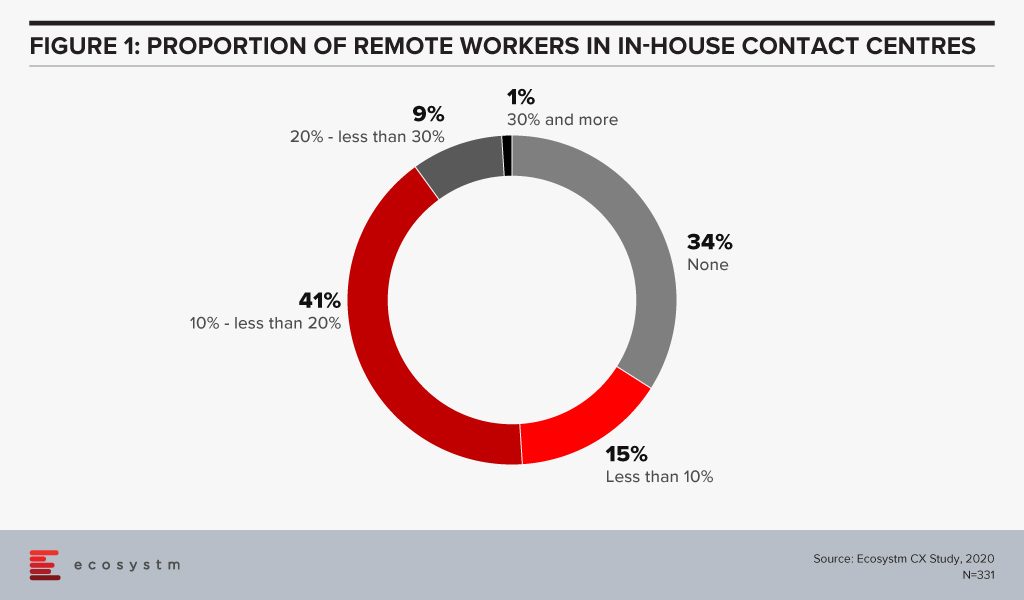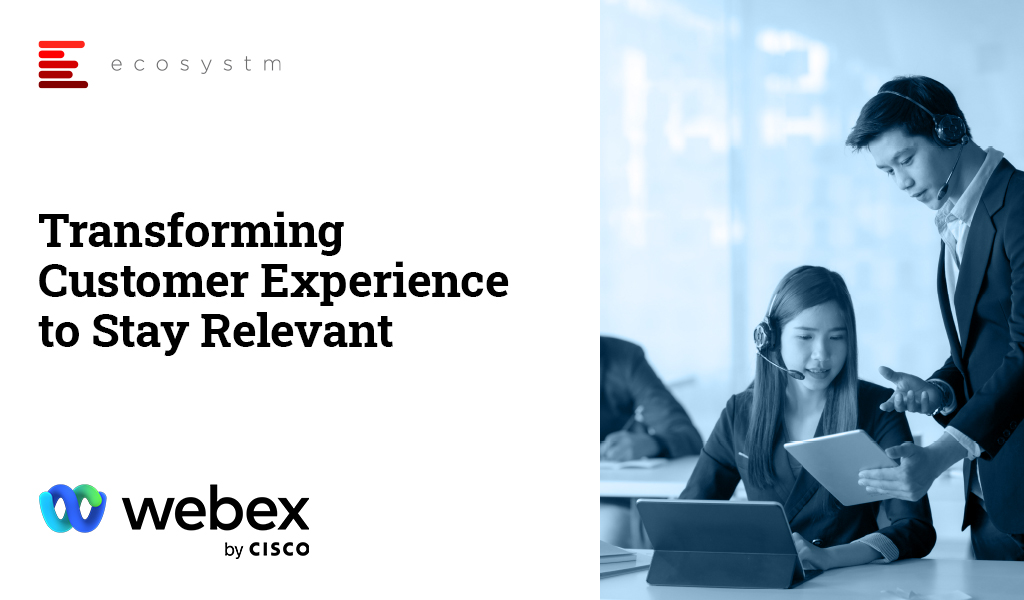Many contact centres in the Asia Pacific were impacted by the disruption in offshore delivery, resulting in a rise of onshore outsourcing. Despite the challenges that the industry has been through, contact centres in the region have demonstrated great resilience by experimenting with various models of customer engagement.
This whitepaper presents the key trends impacting contact centres in the Asia Pacific and the implications for CX decision-makers as they plan their organisations’ customer strategy for 2021. The data cited is from the Ecosystm CX Study and the Digital Priorities in the New Normal Study, that are live and ongoing on the Ecosystm platform.
Download Whitepaper – Transforming Customer Experience to Stay Relevant

(Clicking on this link will take you to the Webex website where you can download the whitepaper)

Uniphore, a provider of Conversational Automation solutions, has announced their intention to acquire Jacada, an Israel-based autonomous customer experience solution provider. Jacada’s low-code/no-code platform will help Uniphore solve complex contact centre challenges using AI and automation. Jacada’s strengths include a low-code optimised interface and AI-enabled contact centre capabilities leading to automation across agent and customer engagements, enhanced knowledge-based guidance for agents and end-to-end analytics and insights.
Jacada has been in the market for around three decades and over time they have built various unified desktop and process optimisation products including RPA for customer service and support.
The acquisition follows Uniphore’s USD 140 million Series D funding round led by Sorenson Capital Partners in March 2021. Earlier this year, Uniphore acquired Emotion Research Lab to add AI and machine learning video capabilities that identify the emotion and engagement levels over video-based communications.
Growing Importance of Agent Assist Solutions
With agents facing pressure in offering customers satisfactory outcomes and at the same time having to manage the high volume of inbound transactions, Agent Assist solutions are high on the agenda for organisations. Remote working has made things even more complex where agents are cut off from their supervisors and not able to walk up to them to seek guidance. These “immediate challenges” have not yet been addressed in every contact centre even a year after the crisis. This presents a good opportunity for Uniphore to own the front and back-office integration piece. The back-office integration segment has become increasingly important as there is a need to fulfill customer requests by ensuring the conversation thread with back-office systems is followed through and communicated back to the agent. This need was heightened during the pandemic due to delays in product arrivals, in shipments, and other delays and miscommunication.
The big challenge also lies in making Agent Assist help the agent perform better and not make their lives more stressful! The design element of Agent Assist is critical. The solution must fit well into the other systems and applications such as CRM, Knowledge Management, and Speech Analytics. You don’t want another solution being pushed on to the agents when they are under pressure to meet customer demands during a 15-minute call.
Conversational Automation and Agent Assist must be evaluated carefully as you are integrating the solution into multiple environments with the clear objective of ensuring that agents only get the right information, in a manner that makes sense for them and at appropriate intervals.

The Growing Importance of Low-code No-code (LCNC)
As contact centres focus on business agility and pivoting fast to cope with sudden market shifts, organisations will benefit from moving programming closer to the contact centre – requiring very little assistance from IT teams.
Having a LCNC platform will now allow Uniphore to build front and back-office experiences in a multi-vendor environment. The need to use intelligent APIs to build workflows is high on the agenda and it helps eradicate the costly efforts and time spent on developers to further extract and build new capabilities at speed.
Jacada has been pushing their value proposition on RPA and Conversational Automation for some time now and this blends well with where Uniphore is going with AI and Automation in the contact centre space. The acquisition will also give Uniphore access to other contact centre technologies that will help them to compete better with a wider range of solutions. With the challenges in managing the agent experience, we can also expect the Workforce Experience Management (WEM) segment to play an important role and intersect with Agent Assist to manage and elevate the agent experience.

Last week saw 8×8 and Verint announce a partnership that aims to deliver integrated cloud-based contact centre services and workforce management applications to medium and large enterprises worldwide. The integrated solution will leverage 8×8’s expertise in unified communications as a service (UCaaS) and contact centre as a service (CCaaS) with Verint’s workforce management solutions.
The Need for Better Workforce Optimisation Solutions
Talking about the need for integrated solutions such as this in the Contact Centre space, Ecosystm Principal Advisor for Enterprise Communications and Contact Centres, Audrey William, says, “With agents working from both their homes and the office, contact centres will be challenged with managing staffing requirements and scheduling. The key to delivering exceptional customer experience will be to have the right agent working on the right assignments, across the right channels. On top of that, contact centres have to manage shifts, flexible work hours and part-time agents working across multiple locations. This does not make workforce optmisation an easy task!”
“Driving better employee experience is a top priority for contact centres – and this will include investments in solutions that can alleviate stress for the agent. The industry continues to be challenged by agent attrition – the most common causes being work overload and stress. To provide a consistently good customer experience, contact centres have to listen better to their agents, understand their workloads better, show empathy, and monitor their emotional well-being A workforce optimisation solution will ensure that inbound enquiries are not impacted, and agents’ times are better utilised, through forecasting and better scheduling.”

Synergy between 8×8 and Verint
The single-vendor integrated communications and contact centre solution is anticipated to create better customer engagement and smoother remote operations by empowering employees and agents to plan, forecast and schedule contact centre activities and manage workloads through omnichannel routing.
William says, “8×8 has been establishing its presence in the unified communications and contact centre solutions space in Asia Pacific, particularly in small and medium enterprises (SMEs). Partnering with a market leader in workforce management such as Verint is a positive step. Verint’s strengths in gap analysis from historical data patterns and predicting will help 8×8’s customers to drive optimisation and accuracy in planning in the contact centre. This will have an impact on reducing overstaffing and overtime. Additionally, it will give agents greater control over their schedules and the flexibility to plan their shifts around their desired hours of work.”
“While 8×8 has its own workforce engagement solution, this partnership demonstrates how 8×8 is elevating its game and wants to offer its customers a more robust workforce management solution through Verint Monet and Verint Enterprise. This solution is also out of the box for 8×8’s customers without the need for professional services. That is a plus!”, says William.

Agents are the most valuable assets in a contact centre. In the current environment, the biggest threat is agents getting infected, causing the closure of contact centres for weeks or possibly even longer. We are already seeing the impact of that with offices being shut, students not going to school and industry gatherings and events being put on hold or cancelled. So having a business continuity plan (BCP) is critical. The BCP should include ways to continue to engage with customers.
The contact centre manages live interactions. Every second there are voice calls coming in, emails received and self-service tools being accessed. It is important to have multiple backup plans – both from a people and a technology perspective – to keep operations running effectively, without calls being put on hold too long or with other channels going unanswered. Contact centres battle with these challenges every day and the situation will get far more serious with the ongoing changes we are witnessing.
Some important considerations include:
Having a backup plan allowing agents working from home
More contact centres today are gearing up to agents working from home, but the process is not an easy one. To begin with, the initial set up includes having the right connectivity and a reliable network. Ensuring that the agent has the right working environment with minimal distraction is crucial. A good quality headset can help. A poor-quality headset will only create unwanted problems with understanding customer issues and handling them. Other concerns include security, tracking how data is being handled, agent under-performance and safety of the agents from an operational and health perspective. Measures such as listening to call recordings and storing them centrally are growing in importance. Multi-factor authentication and analytics using agent logs are some measures that can be put in place.
While there are lots of tools and technologies to monitor and check on agents, the key for home-based agents will be trust. Some outsourced contact centre providers that have been using home-based agents for years have stated that having trust and not micromanaging the agents, is essential for the model to work. Some contact centres have also deployed a BYOD policy for home-based agents assuming the right security, device management, application management and authentication measures are in place.
Organisations should also consider actively recruiting additional home-based agents. These agents could be retirees, currently unemployed or people with mobility issues who prefer to work from home.
Given the difference in the working environment, the metrics used to measure agent performance needs to be modified to be more realistic and fair to both agents and organisations.
Employing home-based agents will drive employment amidst challenges in the economy. Ecosystm research finds that more than a third of organisations do not have provisions for agents working remotely (Figure 1).

For a long time, the industry has talked about the rise of home-based agents and while it has received positive momentum, it has never really taken off in a big way. This time it will.
Managing spikes in voice and non-voice calls
In industries such as healthcare and airlines, call volumes are exceeding normal volumes. Having the ability to deflect the calls to other non-voice channels will be important. It might need the Interactive Voice Response (IVR) scripts to be changed from time to time to manage the flow of the calls. This is when cloud architecture becomes important. The cloud model can be used to make changes to call workflows easily. The sudden peaks will also require changing the channels easily and without intervention from IT. This is where the agility of cloud comes in as it allows changes and additions – for example when 500 agents need to be added or moved to work on other areas – to be made more easily. Ecosystm research finds that currently, only a third of organisations have their contact centre solutions fully on a cloud, with another 66% with partial cloud solutions. This is set to change with the rise in the number of home-based agents.
There should be thought and planning on how to deflect voice calls to other self-service channels. In the current environment, some organisations deploy a call back option when there is an overflow calls. Similarly looking at deflecting voice calls to self-service channels to ease the load on agents should be evaluated.
Managing back up locations (onshore and offshore)
Contact centre operators are looking at ways to isolate agents and keep them safe. Apart from very strict hygiene measures, organisations are also restricting agents to their specific floor. Some are looking at having agents split into different centres, to contain the risk of mass infection.
Several contact centre operators are building contingency plans to route calls to outside the onshore location in case the situation in a site or a cluster worsens.
For back-end contact centre activities and non-voice calls, taking the load off from the current onshore setup and pushing them offshore, can be an option. The best place to start would be by evaluating each client contract and SLAs especially on security, regulation and privacy issues regarding customer data-handling.
There will be a lot to be considered too should the country go into the full lock-down mode as we are starting to see with a few countries. This makes the case for employing home-based agents stronger.
Using messaging apps, the website and FAQs for daily notifications
Many contact centres are informing citizens and customers about the changes in business operations, services offered, refunds, where to go for help, what do to in an emergency and other essential information through the website, app or the updated FAQ. This will help reduce unnecessary voice and non-voice enquiries to the contact centre. During an emergency, it is normal that phone queries will rise and developing a detailed FAQ is critical to counter that. The more detailed the FAQ giving essential information, the more agents will be able to focus on the more essential day to day activities. Several companies are now sending pop-ups within apps about daily changes to avoid an overflow of inbound enquiries.
Virtual Assistants and Conversational AI can help to ease the load
The more intelligent the virtual assistant and conversational AI platform, the more a customer will be able to get the right response. The challenge has been that many platforms are poorly designed and customers get frustrated because they are unable to get the basic information they need. In times of high inbound activity, if answers to simpler queries can be provided through a chatbot, it can help ease the load on agents. It is good to start planning for this as it will take some time to get the virtual assistant platform up and running and even longer for the algorithms to learn from historical patterns to work well. While it may not be the perfect solution now, planning for a Conversational AI can bring some sort of balance back to the contact centre. Having a solid knowledge management system at the back-end cannot be compromised. Without a good knowledge management system, the virtual assistant solution will force customers to leave the self-service platform and place a call to the contact centre, defeating its very purpose.
The challenging situation we are in is undoubtedly putting pressure on contact centres. It is not uncommon now for customers to be put on hold – for more than two hours and in some extreme cases more than 7 hours! In times like this, understanding data and the patterns around data from each customer touchpoint will help plan the next steps on how best to navigate the situation. Testing and pre-testing the channels and the changes made before they go live must be done rigorously.
Whilst these are very challenging times for the economy, the good news is that contact centres are successfully piloting or have already implemented some or all of the above discussed here. Outsourced contact centre providers are running pilots across various locations and applying technology to deal with the challenges they are witnessing daily. Technology has also come a long way in the contact centre space, and by the application of the right technologies, scale, and business continuity measures, resilience can be achieved.
This blog was created with input from CX leaders across the entire Asia Pacific region. The author wishes to thank everyone for their valuable input.






